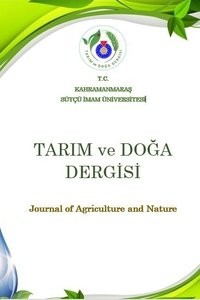In Vitro Gaz Üretim Tekniğinde Rumen Sıvısı Yerine Gübrenin Kullanılma Olanakları
Gaz üretimi, rumen sıvısı, gübre, kaba yem, dane yem
The Possibility of Use of Feces Instead of Rumen Fluid in the in Vitro Gas Production Technique
Gas production, rumen fluid, feces, forage, grain,
___
- AOAC (Association of Official Analytical Chemists). 1990. Official Method of Analysis. 15th. ed. Washington, DC. USA. pp. 66-88.
- Cone, J.W., Van Gelder, A.H., Bachmann, H. 2002. Influence of Inoculum Source on Gas Production Profiles. Animal Feed Science and Technology, 99: 221-231.
- El-Meadaway, A., Mir, Z., Mir, P.S., Zaman, M.S., Yanke, L.J. 1998. Relative Efficacy of Inoculum from Rumen Fluid or Faecal Solution for Determining In Vitro Digestibility and Gas Production. Canadian Journal of Animal Science, 78: 673–679.
- Filya, I., Karabulut, A., Canbolat, Ö., Degirmencioglu T., Kalkan, H. 2002. Bursa Bölgesinde Yetistirilen Yem Hammaddelerinin Besleme Değeri ve Hayvansal Organizmada Optimum Değerlendirme Kosullarının In Vivo ve In Vitro Yöntemlerle Saptanması Üzerinde Arastırmalar. U.Ü. Ziraat Fakültesi Bilimsel Arastırmalar ve Đncelemeler Serisi. No:25, Bursa, s. 1-16.
- Goncalves, L.M.B.O., Borba, A.E.S. 1996. Study of Gas Production Capacity by Three Sources of Inocula. Journal of Agricultural Science, 127(4): 511-515.
- Jezierny, D., Steingass, H., Drochner, W. 2007. In Vitro Gas Production and Fermentation Parameters Using Different Substrates and Pig Faecal Inocula Affected by Bile Extract. Livestock Science, 109 (1-3):145- 148.
- Karaman, S. 2008. Devekusu (Struthio camelus) Kör Bağırsak Đçeriği Kullanılarak Bazı Yem Hammaddelerinin Đn Vitro Yöntemlerle Sindirilebilirliklerinin Belirlenmesi. U.Ü. Fen Bilimleri Enstitüsü Yayınlanmamıs Doktora Tezi Bursa. 96 s.
- Lowman, R.S, Theodora, M.K., Hyslop, J.J., Dhanoa, M.S., Cuddeford, D. 1999. Evaluation of an In Vitro Batch Culture Technique for Estimating the In Vitro Digestibility and Digestible Energy Content of Equine Feeds Using Equine Faeces as the Source of Microbial Inoculum. Animal Feed Science and Technology, 80:11-27.
- Mauricio, R.M., Owen E., Mould, F.L., Givens, I., Theodorou, M.K, France, J., Davies D.R, Dhanoa, M.S. 2001. Comparison of Bovine Rumen Liquor and Bovine Faeces as Inoculum for an In Vitro Gas Production Technique for Evaluating Forages. Animal Feed Science and Technology, 89:33-45.
- Menke, K.H., Raab, L.L., Salewski, A., Steingass, H., Fritz. Schneider, W. 1979. The Estimation of Digestibility and Metabolizable Energy Content of Ruminant Feeding Stuffs from the Gas Production When They are Incubated with Rumen Liqueur In Vitro. Journal of Agricultural Science, 93:217-222.
- Orskov, E.R., Mcdonald, I. 1979. The Estimation of Protein Degradability in The Rumen from Incubation Measurement Weighed according to Rate of Passage. Journal of Agricultural Science, 92: 499- 503.
- SPSS. 2002. SPSS for windows. Release 11.5.0. SPSS Inc. Chicago, USA.
- Tilly, J.M.A., Terry, R.A. 1963. A Two-Stage Technique for the Digestion of Forage Crops. Journal of British Grassland Society, 18: 104-111.
- Varadyova, Z., Baran, M., Zelenak, I. 2005. Comparison of Two In Vitro Fermentation Gas Production Methods Using both Rumen Fluid and Faecal Inoculum from Sheep. Animal Feed Science and Technology, 123-124(1):81-94.
- Yayın Aralığı: 6
- Başlangıç: 1997
- Yayıncı: Kahramanmaraş Sütçü İmam Üniv.
Bazı Önemli Yazlık Sebzelerin Çimlenme Asamasında Nikele Tepkisi
İrfan Ersin AKINCI, Ülkü ÇALIŞKAN
Aykırı Gözlemlerin Belirlenmesinde Kullanılan Bazı Đstatistikler
Fatih ÜÇKARDEŞ, Suat ŞAHİNLER, Ercan EFE
In Vitro Gaz Üretim Tekniğinde Rumen Sıvısı Yerine Gübrenin Kullanılma Olanakları
